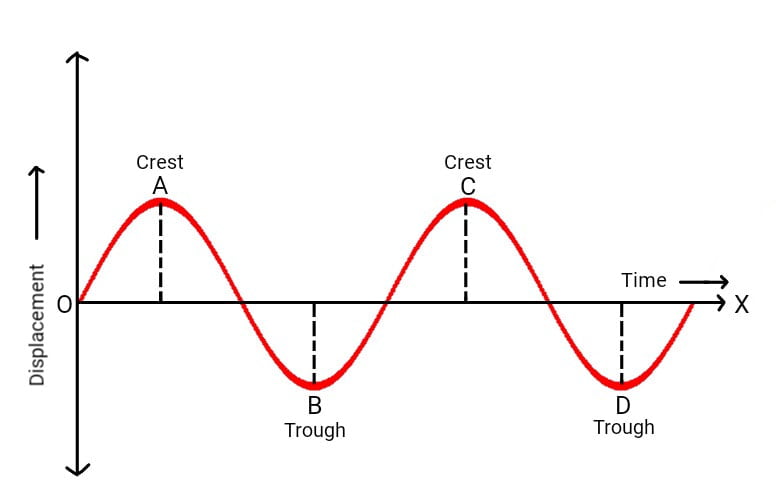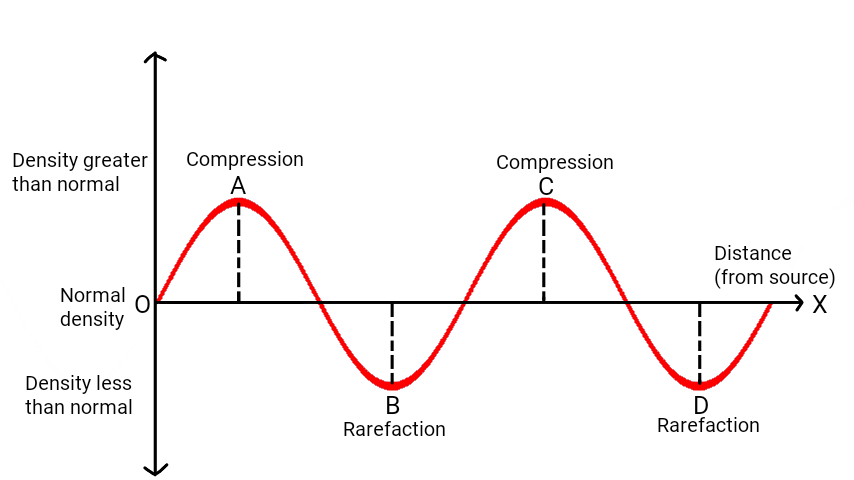The wave which requires a medium for its propagation is known as mechanical wave. Sound wave, water waves, waves on pipes and strings, etc are its examples. For the propagation of a mechanical wave, the medium should have three properties; elasticity, inertia and continuity. Mechanical wave is also called an elastic wave due to the elastic property of the medium.
Sound wave is a mechanical wave; it needs a medium to travel from one point to another. For us, the medium is the atmosphere of the earth. In moon, there is no atmosphere, so sound wave cannot travel there.
Types of Mechanical Wave
According to the vibration of the particles of the medium, mechanical waves are of following two types;
Transverse Wave
If the particles of the medium vibrate perpendicular to the direction of propagation of wave, then the wave is called transverse wave. Water ripples, waves on strings etc. are some of the examples of transverse waves. These waves travel in the form of crests and troughs.

Crest: The position of the maximum positive displacement i.e. the uppermost point of the transverse wave is called crest.
Trough: The position of the maximum negative displacement i.e. the lowest point of the transverse wave is called trough.
The linear distance between two consecutive crests or troughs is the wavelength of the wave.
Graphical Representation
When a transverse wave passes through a medium, some particles of the medium are displaced above the line of zero displacement whereas others are displaced below the line of zero displacement. So, transverse wave is represented graphically by a displacement-distance graph.

Longitudinal Wave
If the particles of the medium vibrate along (to and fro) the direction of propagation of wave, then the wave is called longitudinal wave. Sound wave in air, waves on springs along length, etc. are some of the examples of the longitudinal wave. The particles of the medium vibrate parallel to the direction of propagation of longitudinal waves, so these waves cannot be polarized. A longitudinal wave travels in the form of compressions and rarefactions.

Compression: The region of greater density of a medium due to the flow of a wave is called compression or condensation. In this region, the particles of the medium come close together and hence density and pressure increase.
Rarefaction: The region of smaller density of a medium due to the flow of a wave is called rarefaction. In this region, the particles of the medium move away from each other and hence density and pressure decrease.
Longitudinal waves are also called pressure waves because they create regions of high pressure (in compression) and low pressure (in rarefaction) in the medium where they travel.
Graphical Representation
When a longitudinal wave passes through a medium such as air, then the density of air changes continuously. In compression region, the density of air is high whereas in rarefaction region, the density of air is low. So, longitudinal wave is represented graphically by a density-distance graph.

Mechanical Waves in Different Media
The atoms or molecules of a solid can vibrate about their relatively fixed positions in any directions. So, both longitudinal and transverse wave can travel through a solid.
The shape of a liquid or gas can be changed easily. If the shape of a liquid or gas is changed, it does not try to come back to its original shape. Thus, transverse wave cannot travel in a fluid. On the other hand, every medium (solid, liquid or gas) tries to regain its original density, if the density is changed. Thus, longitudinal wave can travel in all types of media.
Some waves are neither transverse nor longitudinal but combination of both. The particles of the medium of these waves vibrate up and down; and back and forth simultaneously. As a result, the particles move in an elliptical or circular motion. Water ripple formed in water surface is an example of the combination of both longitudinal and transverse motion. As the depth increases, the amplitudes of both component decreases, but the vertical component decreases more rapidly than the horizontal component. Hence, at the bottom, the vertical component becomes zero and the vibration is longitudinal only.

More on Wave And Wave Motion
